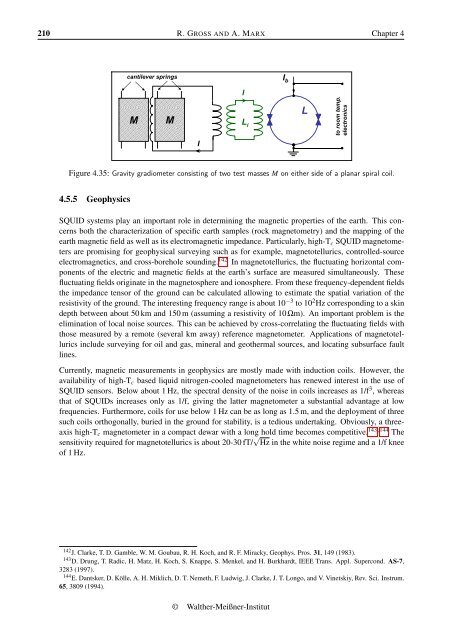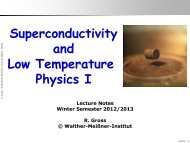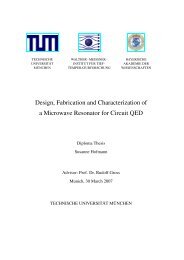Applied Superconductivity - Walther Meißner Institut - Bayerische ...
Applied Superconductivity - Walther Meißner Institut - Bayerische ...
Applied Superconductivity - Walther Meißner Institut - Bayerische ...
- No tags were found...
Create successful ePaper yourself
Turn your PDF publications into a flip-book with our unique Google optimized e-Paper software.
210 R. GROSS AND A. MARX Chapter 4cantilever springsI bIMML iLto room temp.electronicsIFigure 4.35: Gravity gradiometer consisting of two test masses M on either side of a planar spiral coil.4.5.5 GeophysicsSQUID systems play an important role in determining the magnetic properties of the earth. This concernsboth the characterization of specific earth samples (rock magnetometry) and the mapping of theearth magnetic field as well as its electromagnetic impedance. Particularly, high-T c SQUID magnetometersare promising for geophysical surveying such as for example, magnetotellurics, controlled-sourceelectromagnetics, and cross-borehole sounding. 142 In magnetotellurics, the fluctuating horizontal componentsof the electric and magnetic fields at the earth’s surface are measured simultaneously. Thesefluctuating fields originate in the magnetosphere and ionosphere. From these frequency-dependent fieldsthe impedance tensor of the ground can be calculated allowing to estimate the spatial variation of theresistivity of the ground. The interesting frequency range is about 10 −3 to 10 2 Hz corresponding to a skindepth between about 50 km and 150 m (assuming a resistivity of 10Ωm). An important problem is theelimination of local noise sources. This can be achieved by cross-correlating the fluctuating fields withthose measured by a remote (several km away) reference magnetometer. Applications of magnetotelluricsinclude surveying for oil and gas, mineral and geothermal sources, and locating subsurface faultlines.Currently, magnetic measurements in geophysics are mostly made with induction coils. However, theavailability of high-T c based liquid nitrogen-cooled magnetometers has renewed interest in the use ofSQUID sensors. Below about 1 Hz, the spectral density of the noise in coils increases as 1/f 3 , whereasthat of SQUIDs increases only as 1/f, giving the latter magnetometer a substantial advantage at lowfrequencies. Furthermore, coils for use below 1 Hz can be as long as 1.5 m, and the deployment of threesuch coils orthogonally, buried in the ground for stability, is a tedious undertaking. Obviously, a threeaxishigh-T c magnetometer in a compact dewar with a long hold time becomes competitive. 143,144 Thesensitivity required for magnetotellurics is about 20-30 fT/ √ Hz in the white noise regime and a 1/f kneeof 1 Hz.142 J. Clarke, T. D. Gamble, W. M. Goubau, R. H. Koch, and R. F. Miracky, Geophys. Pros. 31, 149 (1983).143 D. Drung, T. Radic, H. Matz, H. Koch, S. Knappe, S. Menkel, and H. Burkhardt, IEEE Trans. Appl. Supercond. AS-7,3283 (1997).144 E. Dantsker, D. Kölle, A. H. Miklich, D. T. Nemeth, F. Ludwig, J. Clarke, J. T. Longo, and V. Vinetskiy, Rev. Sci. Instrum.65, 3809 (1994).© <strong>Walther</strong>-Meißner-<strong>Institut</strong>
















